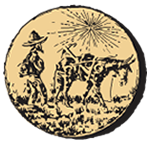Mining and Minerals Education Foundation |
Patrick E. Connor
(1820-1892)
2014 Inductee from Mining's Past
Father of Utah Mining
 Irish-born Patrick Edward Connor emigrated to the United States at age 12. At age 18, he enlisted in the U.S. Army, serving 5 years as a private in the First Dragoons in the Iowa Territory. Upon the outbreak of the Mexican War, he volunteered for duty, distinguishing himself for courage and military skill in battle. When the Civil War broke out, Connor again volunteered for duty and was appointed Colonel of the Third California Infantry with instructions to guard the overland mail route across the west. In October of 1862, he moved his command to Salt Lake City, where he immediately engaged in a “cold war” with the Mormons; relationships were acrimonious at best. During this time, he and his command also engaged in hostile interactions with the Shoshone Indians.
Irish-born Patrick Edward Connor emigrated to the United States at age 12. At age 18, he enlisted in the U.S. Army, serving 5 years as a private in the First Dragoons in the Iowa Territory. Upon the outbreak of the Mexican War, he volunteered for duty, distinguishing himself for courage and military skill in battle. When the Civil War broke out, Connor again volunteered for duty and was appointed Colonel of the Third California Infantry with instructions to guard the overland mail route across the west. In October of 1862, he moved his command to Salt Lake City, where he immediately engaged in a “cold war” with the Mormons; relationships were acrimonious at best. During this time, he and his command also engaged in hostile interactions with the Shoshone Indians.
Connor encouraged his troops to go prospecting after realizing that the best way to dilute the strong influence of the Mormons in Utah was to make the area appealing to outside settlers. Mineral discoveries, with significant silver discoveries, were uncovered at areas now known as Bingham Canyon, Park City, and Alta.
In 1866, Connor, now a General, left the army and plowed his personal fortune into Utah mining. He wrote Utah’s mining laws and introduced navigation on the Great Salt Lake, shipping ores to smelters near the Rush Valley. Connor succeeded in bringing attention to Utah’s vast mineral wealth but failed to profit by it, dying relatively poor in 1892. He was posthumously given the title of the "Father of Utah Mining."
